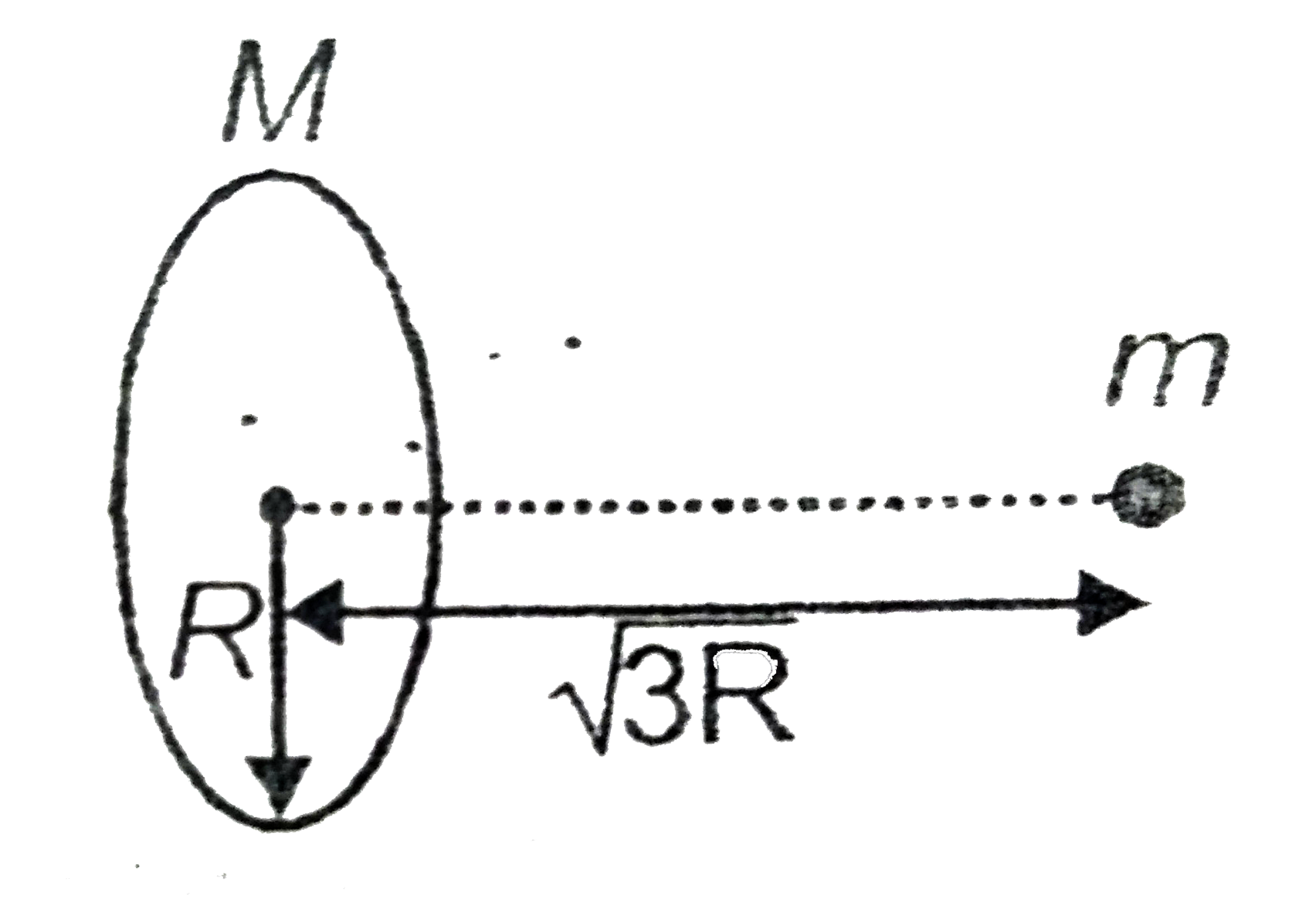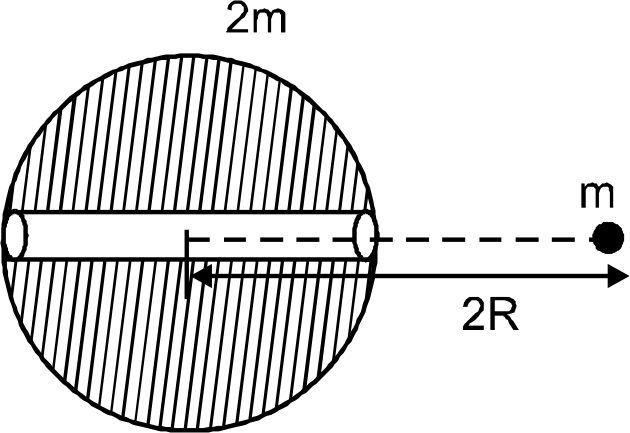A point P lies on the axis of a fixed ring of mass M and radius a, at a distance a from its centre C. A small particle starts from P and reaches C under gravitational attraction only. Its speed at C will be.
√2GMa
√GMa
√2GMa(√2−1)
⎷2GMa(1−1√2)
The correct Answer is:D
To solve the problem, we need to determine the speed of a small particle when it reaches the center of a fixed ring under gravitational attraction. We'll use the principle of conservation of energy to find the solution.
1. Understanding the System:
- We have a fixed ring of mass M and radius a.
- A small particle of mass m starts from point P, which is located on the axis of the ring at a distance a from the center C of the ring.
2. Initial Conditions:
- The initial speed of the particle at point P is 0 (it starts from rest).
- The initial potential energy Ui of the particle due to gravitational attraction from the ring can be calculated using the formula for gravitational potential energy:
Ui=−GMmr
- Here, r is the distance from the mass of the ring to the particle. Since the particle is at a distance a from the center of the ring, we need to find the effective distance from the mass of the ring to the particle.
3. Calculating the Distance:
- The distance from the particle at point P to the ring can be calculated using Pythagoras' theorem. The distance r from the particle to the ring is given by:
r=√a2+a2=√2a2=a√2
4. Potential Energy at Point P:
- Therefore, the initial potential energy Ui when the particle is at point P is:
Ui=−GMma√2
5. Final Conditions:
- When the particle reaches the center C, the distance from the ring to the particle is a.
- The final potential energy Uf at point C is:
Uf=−GMma
6. Kinetic Energy at Point C:
- The final kinetic energy Kf of the particle when it reaches C is given by:
Kf=12mv2
- Here, v is the speed of the particle at point C.
7. Applying Conservation of Energy:
- According to the conservation of energy:
Ui+Ki=Uf+Kf
- Since the initial kinetic energy Ki=0 (the particle starts from rest), we have:
−GMma√2=−GMma+12mv2
8. Rearranging the Equation:
- Rearranging gives:
12mv2=−GMma+GMma√2
- Factoring out −GMma:
12mv2=−GMma(1−1√2)
9. Solving for Speed v:
- Cancel m (assuming m≠0):
12v2=GMa(1−1√2)
- Multiplying both sides by 2:
v2=2GMa(1−1√2)
- Taking the square root:
v=
⎷2GMa(1−1√2)
Final Answer:
The speed of the particle when it reaches the center C is:
v=
⎷2GMa(1−1√2)
- We have a fixed ring of mass M and radius a.
- A small particle of mass m starts from point P, which is located on the axis of the ring at a distance a from the center C of the ring.
- The initial speed of the particle at point P is 0 (it starts from rest).
- The initial potential energy Ui of the particle due to gravitational attraction from the ring can be calculated using the formula for gravitational potential energy:
Ui=−GMmr
- Here, r is the distance from the mass of the ring to the particle. Since the particle is at a distance a from the center of the ring, we need to find the effective distance from the mass of the ring to the particle.
- The distance from the particle at point P to the ring can be calculated using Pythagoras' theorem. The distance r from the particle to the ring is given by:
r=√a2+a2=√2a2=a√2
- Therefore, the initial potential energy Ui when the particle is at point P is:
Ui=−GMma√2
- When the particle reaches the center C, the distance from the ring to the particle is a.
- The final potential energy Uf at point C is:
Uf=−GMma
- The final kinetic energy Kf of the particle when it reaches C is given by:
Kf=12mv2
- Here, v is the speed of the particle at point C.
- According to the conservation of energy:
Ui+Ki=Uf+Kf
- Since the initial kinetic energy Ki=0 (the particle starts from rest), we have:
−GMma√2=−GMma+12mv2
- Rearranging gives:
12mv2=−GMma+GMma√2
- Factoring out −GMma:
12mv2=−GMma(1−1√2)
- Cancel m (assuming m≠0):
12v2=GMa(1−1√2)
- Multiplying both sides by 2:
v2=2GMa(1−1√2)
- Taking the square root:
v=
⎷2GMa(1−1√2)
The speed of the particle when it reaches the center C is:
v=
⎷2GMa(1−1√2)
Similar Questions
A point P(R√3,0,0) lies on the axis of a ring of mass M and radius R. The ring is located in yx-plane with its centre at origin O. A small particle of mass m starts from P and reaches O under gravitational attraction only. Its speed at O will be
View SolutionA particle of mass m is kept on the axis of a fixed circular ring of mass M and radius R at a distance x from the centre of the ring. Find the maximum gravitational force between the ring and the particle.
View Solution
Knowledge Check
A mass m is placed at point P lies on the axis of a ring of mass M and radius R at a distance R from its centre. The gravitational force on mass m is
AGMm√2R2BGMm2R2CGMm2√2R2DGMm4R2
Draw two tangents to a circle of radius 3.5 cm from a point P at a distance of 6.2 cm from its centre.
View SolutionFour particles, each of mass M and equidistant from each other, move along a circle of radius R under the action of their mutual gravitational attraction. The speed of each particle is:
View SolutionFour particles, each of mass M and equidistant from each other, move along a circle of radius R under the action of their mutual gravitational attraction. The speed of each particle is:
View SolutionFour particles, each of mass M and equidistant from each other, move along a circle of radius R under the action of their mutual gravitational attraction. The speed of each particle is:
View SolutionA point particle of mass m is released from a distance √3R along the axis of a fixed ring of mass M and radius R as shown in figure. Find the speed of particle as it passes through the centre of the ring.

View SolutionFind the intensity of gravitational field at a point lying at a distance x from the centre on the axis of a ring of radius a and mass M.
View Solution
A solid spherical planet of mass 2m and radius 'R' has a very small tunnel along its diameter. A small cosmic particle of mass m is at a distance 2R from the centre of the planet as shown. Both are initially at rest, and due to gravitational attraction, both start moving toward each other. After some time, the cosmic particle passes through the centre of the planet. (Assume the planet and the cosmic particle are isolated from other planets)
View Solution
